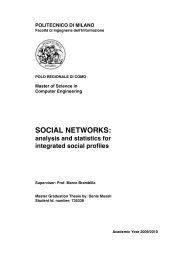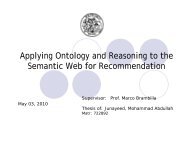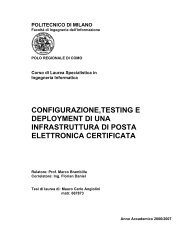Thesis full text (PDF) - Politecnico di Milano
Thesis full text (PDF) - Politecnico di Milano
Thesis full text (PDF) - Politecnico di Milano
You also want an ePaper? Increase the reach of your titles
YUMPU automatically turns print PDFs into web optimized ePapers that Google loves.
2.4.3 OWL<br />
OWL (Web Ontology Language) is the latest recommendation of W3C [21], and is probably the<br />
most popular language for creating ontologies today. It is also the last technical component. The<br />
good news is that it is built on RDF schema; as you have already established a solid<br />
understan<strong>di</strong>ng of RDF schema, much of the material here is going to look familiar to you.<br />
OWL = RDF schema + new constructs for expressiveness<br />
Therefore, all the classes and properties provided by RDF schema can be used when creating an<br />
OWL document. OWL and RDF schema have the same purpose: to define classes, properties,<br />
and their relationships. However, compared to RDF schema, OWL gives us the capability to<br />
express much more complex and richer relationships. The final result is that can construct agents<br />
or tools with greatly enhanced reasoning ability. Therefore, OWL often used for the purpose of<br />
ontology development.<br />
RDF schema is still a valid choice, but it’s obvious limitations compared to OWL will always<br />
make it a second choice. Compared to RDFS, OWL has much more powerful expressiveness.<br />
2.5 Ontology<br />
There are several aspects of this definition that need to be clarified. First, this definition states<br />
that ontology is used to describe and represent an area of knowledge. In other words, ontology is<br />
domain specific; it is not there to represent all knowledge, but an area of knowledge. A domain is<br />
simply a specific subject area or sphere of knowledge, such as photography, me<strong>di</strong>cine, real<br />
estate, education, etc.<br />
Second, ontology contains terms and the relationships among these terms. Terms are often called<br />
classes, or concepts; these words are interchangeable. The relationships between these classes<br />
can be expressed by using a hierarchical structure: super classes represent higher-level concepts<br />
and subclasses represent finer concepts, and the finer concepts have all the attributes and features<br />
that the higher concepts have.<br />
20



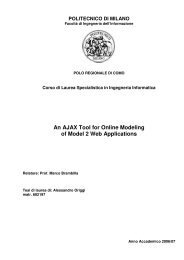
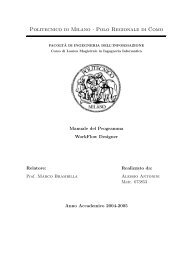
![Full text preview of the chapter [PDF] - Politecnico di Milano](https://img.yumpu.com/44021924/1/180x260/full-text-preview-of-the-chapter-pdf-politecnico-di-milano.jpg?quality=85)
